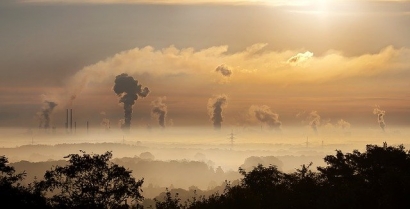Globally, the International Energy Agency estimates that moving to a net-zero economy would create 30 million jobs worldwide by 2030 across energy, construction, and automotive sectors, 65% of which will be high-skilled jobs. The United States is committed to realizing not only the emissions reductions potential, but also the economic growth and jobs creation opportunities across key sectors.
Through tackling methane emissions, spurring innovations, and supporting sustainable agriculture, President Biden is announcing bold steps that will push the U.S. clean energy economy forward and create good-paying jobs. President Biden is unveiling a U.S. Methane Emissions Reduction Action Plan that redoubles efforts from across the government to dramatically reduce U.S. methane emissions, cut consumer costs, protect workers and communities, maintain and create high-quality, union-friendly jobs, and promote U.S. innovation and manufacturing of critical new technologies.
Reducing Methane Emissions: Methane emissions are a major contributor to climate change, which is why President Biden is taking critical, commonsense steps at home to reduce methane across the economy – all while rallying the rest of the world to take similar bold actions.
This is why President Biden in September announced that the United States was joining with the European Union in challenging the world to meet a Global Methane Pledge and reduce the world’s methane emissions 30% from 2020 levels by 2030. More than 90 governments have now joined the pledge, including 15 of the world’s top 30 methane emitters: the United States, EU, Indonesia, Pakistan, Argentina, Mexico, Nigeria, Iraq, Vietnam, Canada.
The new U.S. Methane Emissions Reduction Action Plan is an ambitious, whole-of-government initiative that uses all available tools – commonsense regulations, catalytic financial incentives, transparency and disclosure of actionable data, and public and private partnerships – to identify and cost-effectively reduce methane emissions from all major sources. These actions will protect public health, promote U.S. innovation in new technologies, and help employee tens of thousands of skilled workers across the country. The plan aims to reduce:
- Oil & Gas Industry Methane Emissions: The oil and gas industry is the largest industrial source of methane emissions in the United States, responsible for approximately 30% of total methane emissions. That is why on January 20, 2021, the first day of his Administration, President Biden issued Executive Order 13990, directing the Environmental Protection Agency (EPA) to issue regulations under the Clean Air Act to reduce the oil and gas industry’s methane emissions.
The EPA is today proposing new regulations that will significantly broaden and strengthen methane emissions reduction for new oil and gas facilities. In addition, for the first time ever, it will require that states develop plans that will reduce methane emissions from existing sources nationwide—including from an estimated 300,000 oil and gas well sites. Overall, the proposed requirements would reduce emissions from covered sources, equipment, and operations by approximately 75%.
The Department of Transportation’s Pipeline and Hazardous Materials and Safety Administration (PHMSA) is implementing the bipartisan PIPES Act by upgrading and expanding pipeline rules that will, among other things, require operators to cut methane leaks and excursions. And the Department of the Interior (DOI) is focusing on opportunities to tackle the venting and flaring of methane from oil and gas operations and well closures on public lands and waters.
- Landfill Methane Emissions: Landfills are the second largest industrial source of methane in the United States. Building on efforts earlier this year to put in place an enforceable federal backstop plan to ensure emissions reductions from large municipal landfills, EPA is ramping up an initiative to reduce the food loss and waste that serves as a major contributor to landfill methane emissions. EPA is also boosting its voluntary landfill methane outreach program to achieve a national goal of 70 percent methane emissions capture for all landfills around the country.
- Emissions by Plugging Oil & Gas Wells and Remediating Abandoned Mines: Under the President’s Build Back Better plan, DOI will launch an aggressive program to plug hundreds of thousands of orphan oil and gas wells, including many that are still venting methane, employing union workers across the country. Build Back Better would scale up the current Abandoned Mine Land program, funding historic remediation efforts that would result in dramatic methane emissions reductions from thousands of currently leaking, abandoned coal mines. This scaled up program would also enlist tens of thousands of skilled workers, especially in energy communities across the country.
- Agricultural Methane Emissions: In his early Executive Order on “Tackling the Climate Crisis at Home and Abroad,” the President called on the Department of Agriculture (USDA) to work with farmers and ranchers to identify voluntary, incentive-based approaches that will advance climate goals. In response, USDA is pursuing multiple workstreams to reduce methane emissions from the agricultural sector, including (1) the adoption of alternative manure management systems and other methane-reducing practices; (2) the expansion of on-farm generation and use of renewable energy; (3) the development of a climate-smart agricultural commodities partnership initiative and (4) increased investments in agricultural methane quantification and related innovations
The United States is also announcing that it will be joining the High-Level Panel for a Sustainable Ocean Economy. This multi-national initiative is harnessing the power of the ocean to tackle the climate crisis, provide jobs and food security, and accelerate sustainable uses of the ocean. As a member of the Ocean Panel, the U.S. will develop a national plan to sustainably manage our ocean area under national jurisdiction. COP26 is a timely moment to join this initiative.
The ocean sustains all life on this planet, yet its health is under threat from greenhouse gas emissions and other stressors. At the same time, the ocean is a source of climate solutions, from reducing shipping emissions, to scaling up offshore renewable energy, to protecting coastal ecosystems that store carbon and improve climate resilience. This is one step in continued efforts to engage on protecting the ocean, including partnering with Palau on the Our Ocean Conference in 2022.


